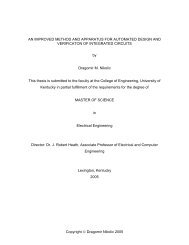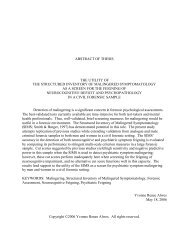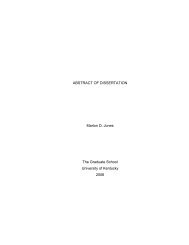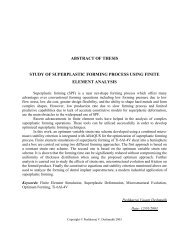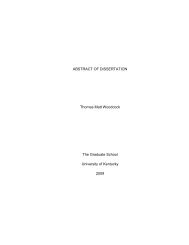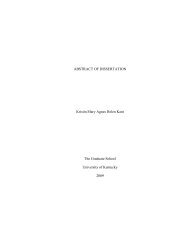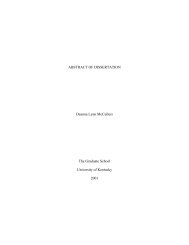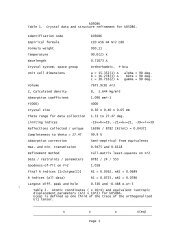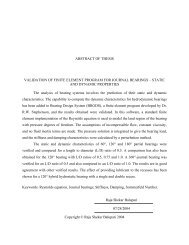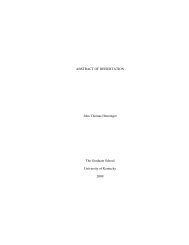ABSTRACT OF THESIS SCHOTTKY DIODES ON COPPER ...
ABSTRACT OF THESIS SCHOTTKY DIODES ON COPPER ...
ABSTRACT OF THESIS SCHOTTKY DIODES ON COPPER ...
Create successful ePaper yourself
Turn your PDF publications into a flip-book with our unique Google optimized e-Paper software.
<strong>ABSTRACT</strong> <strong>OF</strong> <strong>THESIS</strong><strong>SCHOTTKY</strong> <strong>DIODES</strong> <strong>ON</strong> <strong>COPPER</strong> PHTHALOCYANINE NANOWIRE ARRAYSEMBEDDED IN POROUS ALUMINA TEMPLATESVertically aligned nanowire arrays of copper phthalocyanine (CuPc) and CuPc-AlSchottky diodes, of controllable diameter and length were fabricated by cathodicelectrodeposition of CuPc into anodized alumina (AAO) templates, followed by annealing at 300ºC in Argon. AAO over Aluminum tape and that over ITO-glass were both used as startingtemplates for the device fabrication. Depending on the dimensions of the starting AAO template,diameters of CuPc nanowires ranged from 30 nm to 40 nm and the lengths ranged from 500 nm to1 µm. The temperature dependence of the phase and the absorption spectrum of the nanowires arereported. The electrodeposited nanowires (as prepared) had the preferred crystallite orientation ofthe α-phase. ITO formed the ohmic contact and Schottky contacts were formed between CuPcand aluminum. Insertion of a thin layer of PEDOT:PSS between CuPc nanowires and the ITOelectrode improved the contact and reduced the series resistance by an order of magnitude.Schottky diodes were characterized and analyzed at room temperature and at cryogenictemperatures.KEYWORDS: Schottky diode, Copper Phthalocyanine (CuPc), Nanowires, Anodic AluminumOxide (AAO), Electrodeposition.Goutam ChintakulaOctober 24 th 2008
<strong>SCHOTTKY</strong> <strong>DIODES</strong> <strong>ON</strong> <strong>COPPER</strong> PHTHALOCYANINE NANOWIRE ARRAYSEMBEDDED IN POROUS ALUMINA TEMPLATESByGoutam Chintakula____________________________________(Dr. Vijay P Singh)____________________________________(Dr. YuMing Zhang)____________________________________
RULES FOR THE USE <strong>OF</strong> <strong>THESIS</strong>Unpublished thesis submitted for the Master’s degree and deposited in the University ofKentucky Library are as a rule open for inspection, but are to be used only with due regard to therights of the authors. Bibliographical references may be noted, but quotations or summaries ofparts may be published only with the permission of the author, and with the usual scholarlyacknowledgments.Extensive copying or publication of the dissertation in whole or in part also requires the consentof the Dean of the Graduate School of the University of Kentucky.A library that borrows this dissertation for use by its patrons is expected to secure thesignature of each user.NameDate____________________________________________________________________________________________________________________________________________________________________________________________________________________________________________________________________________________________________________________________________________________________________________________________________________________________________________________________________________________________________________________________________________________________________________________________________________________________________________________________________________________________________________________________________________________________________
<strong>THESIS</strong>Goutam ChintakulaThe Graduate SchoolUniversity of Kentucky2008
<strong>SCHOTTKY</strong> <strong>DIODES</strong> <strong>ON</strong> <strong>COPPER</strong> PHTHALOCYANINE NANOWIRE ARRAYSEMBEDDED IN POROUS ALUMINA TEMPLATES<strong>THESIS</strong>A thesis submitted in partial fulfillment of the requirements for the degree of Master ofScience in Electrical Engineering in the College of Engineering at theUniversity of KentuckyByGoutam ChintakulaLexington, KentuckyDirector: Dr. Vijay P. Singh, ProfessorElectrical and Computer EngineeringLexington, Kentucky2008Copyright © Goutam Chintakula 2008
DEDICATI<strong>ON</strong>To Parents, sister and all my family members
ACKNOWLEDGEMENTSI would like to take this opportunity to express my sincere thanks and heartfelt gratitudeto my academic advisor and thesis chair Dr. Vijay Singh for his guidance and support throughoutmy thesis. I am very thankful for his constant encouragement during the thesis. I also would liketo extend my thanks to Dr. Todd Hastings and Dr. J. Robert Heath for serving on my thesiscommittee and providing me with invaluable comments and suggestions for improving this thesis.I extend my deepest gratitude and heartfelt thanks to Dr. Suresh Rajaputra and Dr.Sovannary Phok without whom the thesis would have never taken its present shape. I am greatlyindebted for their technical support throughout my thesis. I would also like to thank othermembers of the group for their technical assistance and support.My parents and my friends have been great sources of support throughout my studies inthe USA and before that. They have had to live with many years of separation from me while Ihave been involved in my academic pursuits in the USA. My friends have given me a lot of lovewithout which this work would not have been possible.iii
Table of ContentsACKNOWLEDGEMENTS ......................................................................................................... iiiList of Tables .................................................................................................................................. vList of figures ................................................................................................................................. viList of Files .................................................................................................................................... ix1. Introduction ................................................................................................................................ 12. Theory ......................................................................................................................................... 52.1 Metal-Semiconductor Junctions ............................................................................................................ 52.1.1 Schottky Contacts .......................................................................................................................... 52.1.2 Ohmic Contacts ............................................................................................................................. 72.1.3 Schottky Diode characteristics....................................................................................................... 82.2 Organic-Based Photovoltaics ................................................................................................................ 92.3 Device Structure and operation ........................................................................................................... 113. Experimental Procedure ......................................................................................................... 133.1 Fabrication of nanoporous alumina over Aluminum tape ................................................................... 133.2 Fabrication of nanoporous alumina using ITO-glass templates .......................................................... 133.3 Electrodeposition of CuPc in AAO template ...................................................................................... 143.4 Spin Coating of PEDOT:PSS .............................................................................................................. 153.5 Sputtering of ITO ................................................................................................................................ 153.6 E-Beam Evaporation of ITO and Aluminum ...................................................................................... 164. Results and Discussion ............................................................................................................. 174.1 Characterization of CuPc using Scanning Electron Microscopy (SEM)............................................. 174.2 Optical Absorption .............................................................................................................................. 184.3 X-Ray Diffraction Characteristics ....................................................................................................... 214.4 Schottky Diode Characteristics ........................................................................................................... 234.5 Low Temperature Characteristics ....................................................................................................... 345. Conclusions and future prospects ........................................................................................... 43References ..................................................................................................................................... 44Vita ................................................................................................................................................ 46iv
List of TablesTable 1: Diode parameters for the CuPc-Al Schottky diodes in Dark over Al-tape(Type-I)…………………………………………………………………………………….……..26Table 2: Diode parameters for the CuPc-Al Schottky diodes in Light over Al-tape(Type-I)…………………………………………………………………………………….……..27Table 3: Diode parameters for the CuPc-Al Schottky diodes in Dark over ITO-glass(Type-II)...………………………………………………………………………………………...30Table 4: Diode parameters for the CuPc-Al Schottky diodes in Light over ITO-glass(Type-II)...………………………………………………………………………………………...30Table 5: Diode parameters for the ITO-CuPc-Al and ITO-PEDOT:PSS-CuPc-Al Schottky diodeson 500nm long CuPc nanowires embedded in a porous alumina template (Type-I)……..………32Table 6: Diode parameters for the IR 90SQ045 Schottky diode (Cooling cycle)..........................37Table 7: Diode parameters for the IR 90SQ045 Schottky diode at different temperatures (Heatingcycle)……………………………………………………………………………………………...38Table 8: Diode parameters for the CuPc-Al Schottky diode with 500nm long CuPc nanowires(Cooling cycle)……………………………………………………………………………………42Table 9: Diode parameters for the CuPc-Al Schottky diode with 500nm long CuPc nanowires(Heating cycle)……………………………………………………………………………………42v
List of figuresFigure 1: Strategy for the synthesis of phthalocyanines [Ref. 2] ..................................................... 2Figure 2: Typical starting materials for the synthesis of phthalocyanines [Ref. 2] ......................... 2Figure 3: Schematic representation of the molecular structure of CuPc [Ref. 31] .......................... 3Figure 4: A Schottky barrier between a metal and an n-type semiconductor with Φ m > Φ s ; (a)band diagrams before joining; (b) equilibrium band diagram for the junction ................................ 5Figure 5: A Schottky barrier between a metal and a p-type semiconductor with Φ m < Φ s ; (a) banddiagrams before joining; (b) equilibrium band diagram for the junction ......................................... 6Figure 6: An Ohmic contact between a metal and an n-type semiconductor with Φ m < Φ s ; (a) banddiagrams before joining; (b) equilibrium band diagram for the junction ......................................... 7Figure 7: An Ohmic contact between a metal and a p-type semiconductor with Φ m > Φ s ; (a) banddiagrams before joining; (b) equilibrium band diagram for the junction ......................................... 8Figure 8: Biasing a Schottky barrier; (a) Forward bias, (b) Reverse bias ........................................ 9Figure 9: Device Structure Type-I; CuPc-Al forms a Schottky contact; CuPc ITO forms an ohmiccontact ............................................................................................................................................ 12Figure 10: Device Structure Type-II; CuPc-Al forms a Schottky contact; CuPc-ITO forms anohmic contact ................................................................................................................................. 12Figure 11: Energy level diagram of CuPc-Al junction .................................................................. 13Figure 12: Electrodeposition setup ................................................................................................ 15Figure 13: SEM micrographs: (a) top view and (b) cross section of a typical 0.5 µm thickAAO/Al template anodized at 20V followed by 25V .................................................................... 17Figure 14: Scanning electron micrographs of CuPc nanowires electrodeposited in AAO/Altemplate at room Temperature; cross sectional views at, (a) a location near the top, (b) a locationnear the bottom of the pores ........................................................................................................... 18Figure 15: Optical absorption of CuPc nanowires for different nanowire lengths varying from500nm to 1000nm annealed at 200 o C ............................................................................................ 19Figure 16: Optical absorption of CuPc nanowires for different nanowire lengths varying from500nm to 1000nm annealed at 300 o C ............................................................................................ 19Figure 17: Optical absorption spectra of electrodeposited CuPc nanowires embedded in an AAOtemplate on a glass-ITO substrate .................................................................................................. 20vi
Figure 18: Scanning electron micrographs of CuPc electrodeposited in AAO template on a glass-ITO substrate using (a) 120V/0V pulse voltage and (b) 15V-30V D.C ramp voltage ................... 21Figure 19: X-ray Diffraction pattern of electrodeposited CuPc nanowires in AAO template on aglass-ITO substrate (a) as-deposited (AD), (b) annealed at 100 o C (plot (b) scaled for clarity) ..... 22Figure 20: X-ray Diffraction pattern of electrodeposited CuPc nanowires in AAO template on aglass-ITO substrate: (a) annealed at 200 o C, (b) annealed at 300 o C (plot (b) scaled for clarity) .... 22Figure 21: J-V characteristics of a CuPc-Al Schottky diode with 500 nm long CuPc nanowiresover Al-tape (Type-I)..................................................................................................................... 23Figure 22: J-V characteristics of a CuPc-Al Schottky diode with 600 nm long CuPc nanowiresover Al-tape ................................................................................................................................... 24Figure 23: J-V characteristics of a CuPc-Al Schottky diode with 800 nm long CuPc nanowiresover Al-tape ................................................................................................................................... 24Figure 24: J-V characteristics of a CuPc-Al Schottky diode with 1000 nm long CuPc nanowiresover Al-tape ................................................................................................................................... 25Figure 25: J-V characteristics of a CuPc-Al Schottky diode in Dark over Al-tape (Type-I);comparing different thicknesses .................................................................................................... 25Figure 26: J-V characteristics of a CuPc-Al Schottky diode in Light over Al-tape (Type-I);comparing different thicknesses .................................................................................................... 26Figure 27: J-V characteristics of a CuPc-Al Schottky diode with 500 nm long CuPc nanowiresover ITO-glass (Type-II) templates ............................................................................................... 27Figure 28: J-V characteristics of a CuPc-Al Schottky diode with 600 nm long CuPc nanowiresover ITO-glass templates ............................................................................................................... 28Figure 29: J-V characteristics of a CuPc-Al Schottky diode with 800 nm long CuPc nanowiresover ITO-glass templates ............................................................................................................... 28Figure 30: J-V characteristics of a CuPc-Al Schottky diode with 1000 nm long CuPc nanowiresover ITO-glass templates ............................................................................................................... 29Figure 31: J-V characteristics of a CuPc-Al Schottky diode in Dark over ITO-glass (Type-II)templates; comparing different thicknesses ................................................................................... 29Figure 32: J-V characteristics of a CuPc-Al Schottky diode in Light over ITO-glass (Type-II)templates; comparing different thicknesses ................................................................................... 30Figure 33: J-V characteristics of a CuPc-Al Schottky diode with 500 nm long CuPc nanowires . 31vii
Figure 34: I-V characteristics of ITO-PEDOT: PSS-CuPc-Al Schottky diode with 500nm longCuPc nanowires ............................................................................................................................. 32Figure 35: The Low Temperature I-V characteristics of IR 90SQ045 Schottky diode; coolingcycle ............................................................................................................................................... 34Figure 36: Figure 34 with temperatures from 295 K to 50 K ........................................................ 35Figure 37: Figure 34 with temperatures from 50 K to 4 K ............................................................ 35Figure 38: The Low Temperature I-V characteristics of IR 90SQ045 Schottky diode; heatingcycle ............................................................................................................................................... 36Figure 39: Figure 37 with temperatures from 4 K to 50 K ............................................................ 36Figure 40: Figure 37 with temperatures from 50 K to 295 K ........................................................ 37Figure 41: The Low Temperature I-V characteristics of CuPc-Al Schottky diode; cooling cycle 39Figure 42: Figure 40 with temperatures from 295 K to 50 K ........................................................ 39Figure 43: Figure 40 with temperatures from 50 K to 4 K ............................................................ 40Figure 44: The Low Temperature I-V characteristics of CuPc-Al Schottky diode; heating cycle 40Figure 45: Figure 43 with temperatures from 4 K to 50 K ............................................................ 41Figure 46: Figure 43 with temperatures from 50 K to 295 K ........................................................ 41viii
List of Files1. Thesis pdf......………………………………………………………………………4.78MBix
1. IntroductionFor the past forty years inorganic silicon and gallium arsenide semiconductors, silicondioxide insulators, and metals such as aluminum and copper have been the backbone of thesemiconductor industry. However, there has been a growing research effort in “organicelectronics” to improve the semiconducting, conducting, and light emitting properties of organics(polymers, oligomers) and hybrids (organic–inorganic composites) through novel synthesis andself-assembly techniques. Performance improvements, coupled with the ability to process theseactive materials at low temperatures over large areas on materials such as plastic or paper, mayprovide unique technologies and generate new applications and form factors to address thegrowing needs for computing and enhanced connectivity.The growing need for more efficient and reliable power production has triggered theresearch on Nano-based solar cells. Organic solar cells have recently been proposed as a key forenergy supply because they are compatible with plastics, are flexible and can a cover a large area.Organic materials also have the key advantage of simple and low-temperature thin-filmprocessing through inexpensive techniques such as spin coating, ink-jet printing, stamping,sputtering, E-beam evaporation, thermal evaporation etc. In addition, the flexibility of organicchemistry enables the formation of organic molecules with useful luminescent, photoelectric andconducting properties. The ability of these materials to transport charge (holes and electrons) dueto the π-orbital overlap of neighboring molecules provides their semiconducting and conductingproperties. While very promising with regard to processing, cost, and weight considerations,organic compounds generally have a number of disadvantages, including poor thermal andmechanical stability. In addition, while electrical transport in organic materials has improved, theroom temperature mobility is fundamentally limited by the weak van der Waals interactionsbetween organic molecules as opposed to the stronger covalent and ionic forces found inextended inorganic systems [1].A phthalocyanine is a macrocyclic compound having an alternating nitrogen atom-carbonatom ring structure. A macrocycle is, as defined by IUPAC, "a cyclic macromolecule or amacromolecular cyclic portion of a molecule." The molecule is able to coordinate hydrogen andmetal cations in its center by coordinate bonds with the four isoindole nitrogen atoms. Most of theelements have been found to be able to coordinate to the phthalocyanine macrocycle. Therefore, avariety of phthalocyanine complexes exist [2].1
The Figure 1 below shows that a phthalocyanine macrocycle consists of four identicalcorners. A synthesis strategy, therefore, starts from molecules which correspond to these corners.Such molecules are derivatives of phthalic acid. Several of these starting materials are shown inthe Figure 2 below [reiterated from Wikipedia.com].Figure 1: Strategy for the synthesis of phthalocyanines [Ref. 2]Figure 2: Typical starting materials for the synthesis of phthalocyanines [Ref. 2]The phthalocyanine is a blue-colored dye molecule with high chemical and physicalstability. They have several polymorphic forms, and the crystal structures of metal-free and2
various metal derivatives are different. Metal-free phthalocyanine has at least four polymorphs: α,β, τ, and χ. They have two main electronic absorption regions: the Q band, generally in the range600–700nm, and the Soret band, in the range 300–400nm [18]. In the solid state these bandsgenerally split into two components due to excitonic coupling between overlapping molecules.The effect of this splitting is strongly dependent on the relative orientation and separation ofneighboring molecules, so that different polymorphic forms have very different absorptionspectra.Metal phthalocyanine (MPc) is an excellent organic semiconductor and its optical andelectrical properties have long been studied extensively due to its potential applications toxerography, gas sensors, electronic and photovoltaic devices including field effect transistors andsolar cells. MPc is also expected to be a candidate material for optical detectors with moretunable absorption band and lower cost than its inorganic counterparts. In most of theseapplications, the sensitivity or efficiency of the devices is crucial and usually proportional to thetotal surface area of the MPc. Nanowire arrays can offer a larger surface area compared to thefilms or bulk materials, leading to the enhanced photoelectric conversion efficiency. Furthermore,the nanostructured arrays, because of their special quantum size effect, own a number of uniquephysical and electronic properties that endow them with new and important activities in thenanotechnology science.Figure 3: Schematic representation of the molecular structure of CuPc [Ref. 31]Copper phthalocyanine (CuPc) is one of those MPc organic semiconductors that arefinding applications in a wide variety of optoelectronic devices including light emitting diodes [3-3
5] and solar cells [6-13]. Its molecular structure is shown in Figure 3. Its molecular formula isC 32 H 16 CuN 8 and has a molecular mass of about 576.1. It has five polymorphs [18]: α, β, γ, δ, andε. The monoclinic α and β forms differ in the angle between the stacking axis and the normal tothe molecular plane, which is 26.5° in the former and 45.8° in the latter.Earlier, high open circuit voltages (V oc ) in a single organic heterojunction solar cellinvolving CuPc were reported [11-13]. However short circuit current densities (J sc ) in these cellsas in organic semiconductor solar cells (OSSCs), in general, are low. The major reason for low J scin OSSCs is the rather small exciton diffusion length of a few nm. Nanowire cell designs and useof ordered structures offer a way out of this serious limitation and thus a path to high efficiencyOSSCs [14-15]. These nano-structures have many advantages. First, they are relatively easy tomodel. Second, the dimensions can be controlled to ensure that every spot of the 2semiconductors are within the exciton diffusion length of the interface and third, the presence ofstraight conducting paths to the electrodes minimizes recombination [28].Template based fabrication methods, typically employing electrodeposition, provide adirect way to vary the diameter and length of pores and chemical composition of nanowiresembedded in them. Thus nano-template based technology provides a platform for not onlyachieving higher performance in solar cells and other optoelectronic devices, but also forperforming systematic studies of the effects of size on the characteristics of these nanowires. Themethod is relatively simple and adaptable to large scale production. As a major step in thedevelopment of this technology, CuPc-Al Schottky diodes in a nanowire mode were fabricatedand their characteristics were studied.This work focuses over the fabrication of CuPc-Al Schottky diodes in a nanowire modeusing AAO templates. Device and material characteristics are discussed. Chapter 2 describes thebasic theory behind Metal-Semiconductor junctions and their characteristics, and organic-basedphotovoltaics. The third chapter discusses the experimental details of the CuPc-Al devicefabrication and the forth chapter illustrates the results and discusses the observations made. Thelast chapter summarizes the thesis with the conclusions drawn and presents suggestions for futureresearch work.4
2. Theory2.1 Metal-Semiconductor Junctions2.1.1 Schottky ContactsP-n junction diodes are the basic non-linear devices being used all over the world. Bysimply forming an appropriate metal-semiconductor contact, many of the useful properties of a p-n junction can be achieved. They are particularly useful when high-speed rectification is required.Consider a metal with work function qΦ m . That is energy of qΦ m is required to remove anelectron at the Fermi level to the vacuum outside the metal. When negative charges are broughtnear the metal surface, positive (image) charges are induced in the metal. When this image forceis combined with an applied electric field, the effective work function is somewhat reduced. Suchbarrier lowering is called the Schottky effect and rectifying contacts are generally referred to asSchottky barrier diodes.When the metal is brought in contact with a semiconductor having a work function qΦ s ,charge transfer occurs until the Fermi levels align at equilibrium. When Φ m > Φ s , thesemiconductor Fermi level is initially higher than that of the metal before contact is made asshown in Figure 4.Figure 4: A Schottky barrier between a metal and an n-type semiconductor with Φ m > Φ s; (a)band diagrams before joining; (b) equilibrium band diagram for the junction5
The electrostatic potential of the semiconductor must be raised relative to that of themetal in order to align the two Fermi levels. In the n-type semiconductor of Figure 4, after thecontact has been made, a depletion region W is formed near the junction. The positive charge dueto uncompensated donor ions within W matches the negative charge on the metal. The electricfield and the bending of the bands within W are similar to effects for p-n junctions.At equilibrium, a contact potential of V o is formed at the junction. This potential preventsfurther electron diffusion from the semiconductor conduction band into the metal. The contactpotential is given by the difference in the work function potentials Φ m - Φ s . The potential barrierheight, Φ B , for electron injection from the metal into the semiconductor conduction band is Φ m -χ, where qχ is the electron affinity measured from the vacuum level to the semiconductorconduction band edge. By applying either forward or reverse-bias voltage, the equilibriumpotential difference V o can be decreased or increased as in the p-n junction.Figure 5: A Schottky barrier between a metal and a p-type semiconductor with Φ m < Φ s; (a)band diagrams before joining; (b) equilibrium band diagram for the junctionFigure 5 illustrates a Schottky barrier on a p-type semiconductor, with Φ m < Φ s . In thiscase aligning the Fermi levels at equilibrium requires a positive charge on the metal side and anegative charge on the semiconductor side of the junction. The negative charge is accommodated6
y a depletion region W in which ionized acceptors are left uncompensated by holes. Thepotential barrier V o retarding hole diffusion from the semiconductor to the metal is Φ s - Φ m , andas before this potential can be raised or lowered by the application of voltage across the junction.2.1.2 Ohmic ContactsAn ohmic contact refers to the contact between a metal and a semiconductor to allowcarriers to flow in and out of the semiconductor. An ideal ohmic contact must be capable ofdelivering the required current with no voltage drop between the semiconductor and the metal. Inreal life, therefore, an ohmic contact must have a contact resistance that is as small as possible, tomake it negligible in comparison to the bulk resistance of the semiconductor.Figure 6: An Ohmic contact between a metal and an n-type semiconductor with Φ m < Φ s ; (a)band diagrams before joining; (b) equilibrium band diagram for the junctionIdeal metal-semiconductor contacts are ohmic when the charge induced in the semiconductor inaligning the Fermi levels is provided by majority carriers. For example, in the Φ m < Φ s case ofFigure 6, the Fermi levels are aligned at equilibrium by transferring electrons from the metal tothe semiconductor. This raises the semiconductor electron energies relative to the metal atequilibrium. In this case the barrier to the electron flow between the metal and the semiconductoris small and easily overcome by a small voltage. Similarly, the case Φ m > Φ s (p-type) results ineasy hole flow across the junction. Figure 7 illustrates this.7
Figure 7: An Ohmic contact between a metal and a p-type semiconductor with Φ m > Φ s ; (a)band diagrams before joining; (b) equilibrium band diagram for the junction2.1.3 Schottky Diode characteristicsSince the rectifying contact behaves the same way as a p-n junction diode, the diodeequation holds good for the I-V characteristics of the metal-semiconductor junction. The diodeequation is given byII = II 0 (e qqqqkkkk − 1)where I o is the reverse saturation current, V is the applied voltage, k is the Boltzmann’s constantand T is the temperature. The reverse saturation current, I o , is given bywhere B is effective Richardson constant.II 0 = AAAATT 2 (e −qqΦBB kkkk )When a forward-bias voltage V is applied to the Schottky barrier of Figure 4, the contactpotential is reduced from V o to V o – V as shown in Figure 8(a). As a result, electrons in thesemiconductor conduction band can diffuse across the depletion region to the metal. This givesrise to forward current through the junction. Conversely, a reverse bias increases the barrier to V o+ V r , and electron flow from semiconductor to metal becomes negligible (Figure 8(b)). Here, theforward current is due to the injection of majority carriers from the semiconductor into the metal.8
The absence of minority carrier injection and the associated storage delay time is an importantfeature of Schottky barrier diodes. Their high-frequency properties and switching speed aretherefore generally better than typical p-n junctions.Figure 8: Biasing a Schottky barrier; (a) Forward bias, (b) Reverse bias2.2 Organic-Based PhotovoltaicsAs discussed in Chapter 1, organic photovoltaics offer the long-term potential ofachieving the goal of a PV technology that is economically viable for large-scale powergeneration. Organic-based photovoltaics (OPVs) have many advantages. They are inexpensive,have very high optical absorption coefficients that permit the use of films with thicknesses ofonly several hundred nanometers; are compatible with plastic substrates and can be fabricatedusing high-throughput, low-temperature approaches. Such low-temperature, and therefore lowenergy-consuming,techniques require less capital investment than fabrication techniques for Sibaseddevices. In addition, the possibility of using flexible plastic substrates in an easily scalable,high-speed printing process can reduce the costs for OPVs to make them competitive withinorganic thin-film technologies. Thus, if efficiencies are comparable or even slightly lower thanexisting technologies, there may be compelling cost arguments favoring OPVs.One of the main issues faced by the organic electronics community in general is thestability of the organic materials. Organic materials tend to degrade because of many reasons;9
changes in morphology, loss of interfacial adhesion, and interdiffusion of components [29], a fewto mention. Thus, careful design and materials engineering is required to substantially improvedevice lifetimes. There are a number of other key aspects of organic materials. They allow foralteration of a wide range of properties, including molecular weight, bandgap, molecular orbitalenergy levels, wetting properties, structural properties (rigidity, conjugation length, molecule- tomoleculeinteractions, etc.), and doping. This ability to design and synthesize molecules and thenintegrate them into organic–organic and inorganic–organic composites provides a unique pathwayin the design of materials for novel devices. Additionally, the ability to alter the color of thedevice, allows us to fabricate devices on flexible substrates, and potentially print them in anypattern.Organic electronic materials are conjugated solids where both optical absorption andcharge transport are dominated by partly delocalized π and π* orbitals. They can be broadlyclassified as either small molecules, with molecular weights of less than a few thousand atomicmass units (amu), or polymers, with molecular weights greater than 10,000 amu. Organicphotovoltaic materials differ from inorganic semiconductors in many important aspects. In thecase of organic materials, excitons are strongly bound and do not spontaneously dissociate intoseparate charges. Dissociation requires an input energy of ~100 meV [27] compared to a fewmeV for a crystalline semiconductor. This means that carrier generation does not necessarilyresult from the absorption of light. Charge transport proceeds by hopping between localizedstates, rather than transport within a band, which results in low mobilities. Also, due to the highdegree of disorder in organic solids, their mobilities are low. The spectral range of opticalabsorption is relatively narrow compared to the solar spectrum. Absorption coefficients are highso that high optical densities can be achieved with films less than 100 nm thick. Many organicmaterials are unstable in the presence of oxygen or water as discussed previously. Theintermolecular van der Waals forces in organic solids are weak compared to bonds in inorganiccrystals and much weaker than the intramolecular bonds. As a consequence, all electronic statesare localized on single molecules and do not form bands. The optical excitations are mainly dueto the π to π* transitions. Most conjugated solids absorb in the blue or green; absorption in thered or infrared is harder to achieve.These properties impose some constraints on organic photovoltaic devices.(a) A strong driving force should be present to break up the photogenerated excitons.(b) Low charge carrier mobilities limit the useful thickness of devices.10
(c) Limited light absorption across the solar spectrum limits the photocurrent.(d) Very thin devices mean interference effects can be important.(e) Photocurrent is sensitive to temperature through hopping transport.[Note: Most of the theory in section 2.2 has been taken from the references 29 and 30]2.3 Device Structure and operationTwo types of device structures were investigated as shown in Figures 9-10. In both casesAluminum acts as a cathode and Indium Tin Oxide (ITO) as an anode. In Type-I devices, CuPcnanowires stand over the cathode, Al, inside the alumina (Al 2 O 3 ) template while in Type-IIdevices, CuPc nanowires stand over the anode, ITO, with a thin inter-layer (10 nm to 15 nm) ofTiO. The length of the CuPc nanowires can be varied by varying the length of the aluminatemplate itself. CuPc nanowire lengths of 500 nm to 1 µm were investigated. Alumina acts as awall separating nanowires from each other. The PEDOT:PSS acts as anode buffer layer. It is athin and transparent film (100 nm – 200 nm) and can be spin-coated. It smoothens the surface ofITO anode [26], enhances adhesion to CuPc, and decreases hole injection barrier due to itsrelatively higher work function (5.1 ± 0.1 eV) on ITO and eventually improves the deviceperformance.CuPc, which acts like a p-type semiconductor, has a work function of about 5.3 eV withan energy gap of 1.7 eV. On the other hand aluminum has a work function of about 4.06 eV. Asthe work function of the metal is less than that of the semiconductor (Φ m < Φ s ), which is of p-type, they form a Schottky contact. Figure 11 shows the energy level diagram for CuPc-AlSchottky junction. The difference in the work function provides an electric field at the CuPc-Alinterface. This electric field is sufficient to break up the photogenerated excitons. Absorbedphotons generate excitons that diffuse towards cathode or anode contact where they maydissociate to yield charge pairs or may recombine. Only the layer of organic material, which lieswithin an exciton diffusion length of a contact, can contribute to the photocurrent. Since excitondiffusion lengths are typically 1-10 nm, exciton diffusion limits charge carrier generation..11
Figure 9: Device Structure Type-I; CuPc-Al forms a Schottky contact; CuPc ITO forms anohmic contactFigure 10: Device Structure Type-II; CuPc-Al forms a Schottky contact; CuPc-ITO forms anohmic contact12
Figure 11: Energy level diagram of CuPc-Al junction3. Experimental ProcedureThe device structure of Type-I was fabricated by first preparing Anodized AluminumOxide (AAO) over Aluminum tape, filling it with CuPc by electrodeposition, spin-coatingPEDOT:PSS and finally sputtering ITO. Type-II devices were fabricated by preparing AAO overITO-glass, filling it with CuPc by electrodeposition and finally evaporating Aluminum.3.1 Fabrication of nanoporous alumina over Aluminum tapeThe nanoporous AAO templates were prepared by anodizing aluminum tape at roomtemperature, in a vertical two-electrode cell with platinum as a counter electrode. The electrolytewas a solution containing 0.3 M oxalic acid dissolved in de-ionized water; one side of the tapebeing protected by glue and paper. The 2-step anodization process, reported by S. Phok et al [20],was used in order to obtain highly ordered patterned pores. As the removal of the aluminum oxidebarrier layer is critical for DC electrodeposition, a ramp down voltage was used for the removalof the barrier layer. This resulted in branching and reduced pore diameter at the bottom.3.2 Fabrication of nanoporous alumina using ITO-glass templatesGlass substrates pre-coated with 150 nm thick conductive, transparent ITO anode werepurchased from Delta Technologies. They were 1”x 2” in size with a sheet resistance of 4-813
Ω/square. These templates were sonicated using an ultrasonic bath in acetone for 2 minutes.Then, they were rinsed with isopropyl alcohol (IPA) and finally sonicated in distilled water. Thecleaned samples were dried in Nitrogen. The ITO side of the templates was identified with thehelp of a multimeter by measuring the resistance. Using Torr International E-Beam Evaporator, athin layer (10 nm to 15 nm) of Titanium (Ti) was vacuum evaporated at a chamber pressure of~5.0E-6 torr. The templates were then annealed at 200 o C in air. Annealing oxidizes Ti to formTiO which acts as a good adhesion layer between Aluminum and ITO. Aluminum was thenvacuum evaporated using E-Beam Evaporation with a thickness varying from 500 nm to 1 µmdepending on the thickness of the alumina template required. The 2-step anodization process wasthen carried out as described above followed by a thermal treatment at 200 o C in air for severalhours.3.3 Electrodeposition of CuPc in AAO templateCuPc was electrodeposited inside the pores of alumina template supported by theunderlying aluminum substrate. Pores were 500 nm to 1 µm in length and 20 nm to 30 nm indiameter. The electrolyte was a 50 ml chloroform (CHCl 3 ) solution containing 0.005 grams ofCuPc with 1 ml Trifluoroacetic acid (CF 3 COOH); CF 3 COOH acted as a protonating reagent [19].Using a Fisher Scientific weighing balance, 5 mg of CuPc was weighed into an 80 ml standardbeaker. In order to improve the dissolution of CuPc, a small amount of CHCl 3 was added to thebeaker and stirred before adding CF 3 COOH. The beaker was then filled to 50 ml with CHCl 3 andstirred thoroughly. A 1”x1” platinum electrode was used as anode and the AAO template servedas cathode. Electrodeposition was carried out with an applied DC voltage of 15V - 30V (rampedat the rate of 1V/min). During this electrodeposition step, a thin layer of CuPc (10nm – 50nm)also got deposited over the surface of aluminum oxide; N-N-Dimethylformamide solution wasused for removing this top layer of CuPc. This process was repeated, typically two or three times,until the pores were completely filled with CuPc. The electrodeposited AAO templates were thenannealed at 300 o C in vacuum for 5 hours and allowed to cool to room temperature.14
Figure 12: Electrodeposition setup3.4 Spin Coating of PEDOT:PSSOne of the simplest and most common techniques of depositing thin films onto flatsubstrates is the technique of spin coating. The material to be deposited must be dissolved ordispersed into a solvent of some kind and this solution is then deposited onto the surface andspun-off to leave a uniform layer for subsequent processing stages.For Type-I devices, after thermal treatment, PEDOT:PSS, purchased from Aldrich, wasspin coated using Chemat Technologies spin coater. The spin coating was carried out at 4000RPM for 40 seconds. The spin coated samples were then annealed in vacuum at 100 o C for 60minutes. Annealing removes the excess water molecules in the PEDOT:PSS layer on the sampleand also increases the adhesion between the PEDOT:PSS and CuPc. The samples were thenallowed to cool down to room temperature.3.5 Sputtering of ITOSputtering is a deposition process which physically removes a target material anddeposits a firmly bonded coating onto the sample. The sputtering process occurs by bombardingthe surface of the target material with gaseous ions (normally Ar+) using an RF power source. Asthese ions collide with the target, atoms or occasionally entire molecules of the target material areejected and propelled against the sample, where they form a very tight bond. The resultingcoating is held firmly to the surface by mechanical forces. When compared to evaporation,sputtering can get better uniformity over a large size. But, certain sputtering systems may requirea medium level vacuum that can increase contamination.15
The anode electrode, ITO, was sputtered using Hummer single target sputtering system.The spin-coated samples were masked with an aluminum foil having circular openings of about0.07 cm 2 in area, to define the ITO sputtering areas. The Sputtering was carried out at 0.01 mTorrwith Argon as the gas medium. The density, Z-factor and the thickness of ITO to be sputteredwere pre-programmed in the system. 80 nm of ITO was sputtered at an average rate of 2 A o /sec.The ITO sputtered makes a conducting contact with CuPc nanowires. This is the final step wherewe have the required device Al/CuPc/PEDOT:PSS and (or) ITO ready for characterization.3.6 E-Beam Evaporation of ITO and AluminumA Torr International E-Beam Evaporator was used to evaporate ITO and Al for thefabrication of Type-II devices. The substrate is placed inside a vacuum chamber, in which asource of the material to be deposited is placed in a graphite crucible. An electron beam (E-beam)is aimed at the source material causing local heating. The source material is heated to the pointwhere it starts to boil and evaporate. The vacuum is required to allow the molecules to evaporatefreely in the chamber, and they subsequently condense on all surfaces.Material characterization of the CuPc nanowires fabricated was performed with thetechniques of X-Ray diffraction (Bruker-AXS D8 DISCOVER Diffractometer), opticalabsorption spectroscopy and scanning electron microscopy (Hitachi S-900 field emission SEM).Electrical characterization was performed with an automated system which included an I-V tester,a solar simulator and a HP 4192A LF impedance analyzer.16
4. Results and Discussion4.1 Characterization of CuPc using Scanning Electron Microscopy (SEM)Figure 13 shows the scanning electron micrographs of a typical starting aluminatemplates used for electrodeposition of CuPc.Figure 13: SEM micrographs: (a) top view and (b) cross section of a typical 0.5 µm thickAAO/Al template anodized at 20V followed by 25VThe top view of the template (Figure 13(a)) reveals hexagonal packed pores with porediameter in the 20 nm to 30 nm range and pore spacing in the 30 nm to 40 nm range, for atemplate anodized at 25V at room temperature. The cross-sectional view of this 0.5 µm longAAO/Al template is shown in Figure 13(b). It can be seen that the pores get narrower along thebottom with branching as a result of ramp down voltage. The pore diameters at the bottom of theanodized AAO/Al template ranged from 15 nm to 20 nm.The X-ray diffraction pattern of AAO/Al revealed that the AAO template wasamorphous. Cross sectional view of the AAO sample after electrodeposition, with CuPc fillingthe pores from top to bottom is seen in Figure 14(a). The left side of the image includes the topsurface of the AAO template with the pore openings. Figure 14(b) shows the cross section atanother location near the bottom (Al-Al 2 O 3 interface) of the AAO pores. The unfilled portions ofAAO pores seen in Figure 14(b) are thought to have lost their CuPc nanowires due to the stressproduced during the process of breaking the device and mounting it on the stub for electronmicroscopy.17
Figure 14: Scanning electron micrographs of CuPc nanowires electrodeposited in AAO/Altemplate at room Temperature; cross sectional views at, (a) a location near the top, (b) alocation near the bottom of the poresIn the electrolyte solution, CuPc forms complex structures of the form CuPc (nH) n+ (nvarying from 1 – 4) in the presence of excess CF 3 COOH [19]. These complexes, having a netpositive charge, migrate towards the cathodic alumina substrate. In the experiments, it wasobserved that the CuPc nanowires grow not only from the bottom of the pore but also from thewalls. This can be attributed to the presence of an electric field not only at the bottom of the porebut also on the inner side of the walls of the pore. This electric field is made possible by thepresence of the un-oxidized, metallic aluminum at the central core of the alumina walls, which isin contact with the bottom aluminum substrate.4.2 Optical AbsorptionMeasurement of the optical absorption spectrum of CuPc nanowires grown on aluminumtape (Type-I) was complicated by the presence of the opaque aluminum substrate. Therefore,Type-II devices were used for optical absorption measurements. CuPc has two absorption bands;Sorret band (S-band) in the UV-region and Q-band in the visible region. The S-band is related tothe direct electronic transition from d-π * orbitals. The absorption peaks in the visible region (Qband)are generally interpreted in terms of π-π * excitation between bonding and anti-bondingmolecular orbitals [23].Figures 15-16 show the optical absorption curves for various lengths of CuPc nanowiresannealed at 200 o C and 300 o C.18
Figure 15: Optical absorption of CuPc nanowires for different nanowire lengths varying from500nm to 1000nm annealed at 200 o CFigure 16: Optical absorption of CuPc nanowires for different nanowire lengths varying from500nm to 1000nm annealed at 300 o CCuPc nanowires annealed at 200 o C having a preferred α-phase crystallization, (discussedin section 4.3) had absorption peaks at 620nm and 691nm corresponding to dimer and monomerpeaks respectively. It can be seen from Figure 15 that the dimer phthalocyanine has higher19
absorption when compared to monomer phthalocyanine. When annealed at 300 o C, CuPcnanowires, having β-phase crystallization, had absorption peaks at 644 nm and 724 nm as shownin Figure 16. Also, the peak at longer wavelength (724 nm) has higher absorption value. Thiscould be attributed to the fact that β-CuPc has higher absorption at longer wavelengths whencompared to that of α-CuPc [15].An important observation was that with pulse voltage CuPc deposits as a film but doesnot go into the pores while with DC ramp voltage CuPc fills the pores. To illustrate this, CuPcwas deposited in AAO templates over ITO glass using pulsed voltage in one case and a D.C.ramp voltage in another case. The optical absorption results are shown in Figure 17.Figure 17: Optical absorption spectra of electrodeposited CuPc nanowires embedded in anAAO template on a glass-ITO substrateFor the top curve, the electrolyte was a 150 ml chloroform (CHCl 3 ) solution containing0.004g of CuPc and 5 ml of Trifluoroacetic acid (CF 3 COOH); electrodeposition was conductedfor four minutes, with voltage pulses of 125V amplitude, 2 seconds pulse width and 6 secondstime period. The top CuPc layer was not removed intentionally. For the bottom curve, theelectrolyte was a 50 ml chloroform solution containing 0.005 grams of CuPc with 1 mlTrifluoroacetic acid; electrodeposition was conducted with a D.C. voltage ramped from 15-30 Vat a rate of 1V/min with the top layer removed. Both devices were annealed at 200 o C. The SEMmicrograph of the pulse deposited CuPc showed a thick CuPc film over the top (~700nm) but no20
deposition inside the pores (Figure 18a) while with D.C. voltage CuPc filled the pores formingnanowires (~500nm) (Figure 18(b)). Thus, we note that a D.C ramp voltage is preferable forgetting the CuPc into the pores of AAO.Figure 18: Scanning electron micrographs of CuPc electrodeposited in AAO template on aglass-ITO substrate using (a) 120V/0V pulse voltage and (b) 15V-30V D.C ramp voltageThe absorption curves for both conditions show peaks at 620 nm and 691 nm. The filmdeposited with 125V pulse showed greater absorption than the nanowires deposited with D.C.ramp voltage. This could be attributed to the fact that CuPc film formed over alumina (Figure18(a)) has a greater quantity of CuPc when compared to CuPc nanowires inside the pores (Figure18(b)), as nearly 50% of the volume is occupied by alumina in the later case. As alumina istransparent to visible light, the alumina part of the device does not contribute to absorption. Alsothe film formed (700nm) is thicker than the nanowire length (500nm).4.3 X-Ray Diffraction CharacteristicsIt is well known that CuPc has three dominant crystal phases: α-, β- and χ-phases [25]. Figures19-20 show the X-ray diffraction pattern of CuPc nanowires electrodeposited into the AAO andsubjected to post deposition annealing treatments. Annealing was carried out for 5 hours invacuum ambient in each case. The X-ray diffraction pattern of the as-deposited nanowires (Figure19(a), (AD)), those annealed at 100 o C (Figure 19(b)), and those annealed at 200 o C (Figure 20(a)),show the dominance of α−phase. When annealed at 300 o C, β−phase becomes dominant (Figure20(b) [17, 26-27]). The peaks at 2θ values of 6.8 o and 7.02 o correspond to α (001) and β (100)21
espectively. In Figures 19-20, the XRD peaks of ITO at 2θ values of 21.3 o , 30º, 35º, 51º and 60ºand alumina peak at 45 o are also observed.Figure 19: X-ray Diffraction pattern of electrodeposited CuPc nanowires in AAO template on aglass-ITO substrate (a) as-deposited (AD), (b) annealed at 100 o C (plot (b) scaled for clarity)Figure 20: X-ray Diffraction pattern of electrodeposited CuPc nanowires in AAO template on aglass-ITO substrate: (a) annealed at 200 o C, (b) annealed at 300 o C (plot (b) scaled for clarity)22
4.4 Schottky Diode CharacteristicsThe current density (J) vs voltage (V) characteristics of Type-I and Type-II devices forvarious thicknesses of CuPc are shown below. The J-V characteristics were also measured underillumination to see if the devices exhibit photovoltaic effect. Figures 21-24 show the J-Vcharacteristics of CuPc-Al Schottky diodes for varying lengths of CuPc nanowires over Al-tape.Figure 25 and Figure 26 show the dark and the light curves for various CuPc nanowire lengthsrespectively. Similarly, Figures 27-32 show the corresponding J-V characteristics of Type-IIdevices.It can be seen that for all the devices current is higher under illumination when comparedto their corresponding dark currents owing to the photoconductance of CuPc. Also, as the lengthof the CuPc nanowires increase, the currents decrease due to the increased internal resistance ofthe device.Figure 21: J-V characteristics of a CuPc-Al Schottky diode with 500 nm long CuPc nanowiresover Al-tape (Type-I)23
Figure 22: J-V characteristics of a CuPc-Al Schottky diode with 600 nm long CuPc nanowiresover Al-tapeFigure 23: J-V characteristics of a CuPc-Al Schottky diode with 800 nm long CuPc nanowiresover Al-tape24
Figure 24: J-V characteristics of a CuPc-Al Schottky diode with 1000 nm long CuPc nanowiresover Al-tapeFigure 25: J-V characteristics of a CuPc-Al Schottky diode in Dark over Al-tape (Type-I);comparing different thicknesses25
Figure 26: J-V characteristics of a CuPc-Al Schottky diode in Light over Al-tape (Type-I);comparing different thicknessesPhotoconductance was exhibited by all the devices but no photo voltaic effect wasobserved. The explanations are discussed later in detail. Diode analysis was performed for thesedevices and the values of the effective reverse saturation current (J o ) and the effective diodeideality factor (η) were calculated to fit the equation,JJ = JJ 0 [ee qqqqηkkkk − 1]……(1)The results are tabulated in Tables 1-2.Table 1: Diode parameters for the CuPc-Al Schottky diodes in Dark over Al-tape (Type-I)NanowireLengthSeries resistance (R s )(Ohms)Effective J o (µA/cm 2 )Diode Ideality Factor(η)500nm 152 10.1 26.5600nm 247 13.8 27800nm 450 10 27.21000nm 1274 4.1 27.926
Table 2: Diode parameters for the CuPc-Al Schottky diodes in Light over Al-tape (Type-I)NanowireLengthSeries resistance (R s )(Ohms)Effective J o (µA/cm 2 )Diode Ideality Factor(η)500nm 37 938.3 23.3600nm 149 139.5 27.7800nm 381 19.9 331000nm 799 10.6 39.8The J-V characteristics of Type-II devices for various thicknesses of CuPc are shown below.Figure 27: J-V characteristics of a CuPc-Al Schottky diode with 500 nm long CuPc nanowiresover ITO-glass (Type-II) templates27
Figure 28: J-V characteristics of a CuPc-Al Schottky diode with 600 nm long CuPc nanowiresover ITO-glass templatesFigure 29: J-V characteristics of a CuPc-Al Schottky diode with 800 nm long CuPc nanowiresover ITO-glass templates28
Figure 30: J-V characteristics of a CuPc-Al Schottky diode with 1000 nm long CuPc nanowiresover ITO-glass templatesFigure 31: J-V characteristics of a CuPc-Al Schottky diode in Dark over ITO-glass (Type-II)templates; comparing different thicknesses29
Figure 32: J-V characteristics of a CuPc-Al Schottky diode in Light over ITO-glass (Type-II)templates; comparing different thicknessesTable 3: Diode parameters for the CuPc-Al Schottky diodes in Dark over ITO-glass (Type-II)templatesNanowireLengthSeries resistance (R s )(Ohms)Effective J o (µA/cm 2 )Diode Ideality Factor(η)500nm 528 17.5 8.9600nm 586 13.4 9.3800nm 660 12.8 9.31000nm 769 18.5 9.5Table 4: Diode parameters for the CuPc-Al Schottky diodes in Light over ITO-glass (Type-II)templatesNanowireLengthSeries resistance (R s )(Ohms)Effective J o (µA/cm 2 )Diode Ideality Factor(η)500nm 433 15 8.9600nm 498 18 9800nm 521 12.2 9.21000nm 588 13.5 9.530
From the J-V analysis we can observe that as the length of the nanowires increase, theseries resistance increases (R s ) and hence the current densities (J) decrease. Also, the diodeideality factor (η) increases with increase in nanowire length. It can also be observed that thecurrent densities are higher under illumination.Figure 33 shows the J-V characteristics of a Type-I Schottky diode with 500 nm longCuPc nanowires embedded in the 0.5 µm deep porous alumina template sitting on top of the unanodizedaluminum electrode. To study the effect of PEDOT: PSS buffer layer, a 100 nm thickPEDOT: PSS layer was introduced between the embedded CuPc nanowires and the ITOelectrode; the device structure was thus modified to Al/CuPc/PEDOT:PSS/ITO. J-Vcharacteristics of this device are shown in Figure 34. The diode parameters are calculated and aretabulated in Table 5. It is interesting to note that the measured value of effective diode idealityfactor (η) is larger than 2.0.Figure 33: J-V characteristics of a CuPc-Al Schottky diode with 500 nm long CuPc nanowiresThe buffer interlayer of PEDOT: PSS is known to improve the contact between CuPc andITO [7, 31]. Comparing Figures 33 and 34, we see that, indeed higher currents and improveddiode behavior is seen in Figure 34; series resistance in high forward bias is reduced by an orderof magnitude. Also, in Figure 34, the sensitivity of the CuPc film and the CuPc-Al junction to theincident light is revealed. Not only is the current higher under illumination, but the lift-off voltagein the forward bias is also smaller. This indicates that, in addition to the effect of the31
photoconductivity of the CuPc film, increase in current with illumination is related to themodification of the CuPc-Al junction interface by the incident light so that the junction barrierpotential is reduced. The diode ideality factors are substantially different, 23.3 in the dark and12.2 under illumination as shown in Table 5.Figure 34: I-V characteristics of ITO-PEDOT: PSS-CuPc-Al Schottky diode with 500nm longCuPc nanowiresTable 5: Diode parameters for the ITO-CuPc-Al and ITO-PEDOT:PSS-CuPc-Al Schottkydiodes on 500nm long CuPc nanowires embedded in a porous alumina template (Type-I)ConditionDark - WithoutPEDOT:PSSLight - WithoutPEDOT:PSSDark - WithPEDOT:PSSLight – WithPEDOT:PSSSeriesresistance(R s ) (Ohms)Effective J o(μA/cm 2 )EffectiveDiodeIdealityFactor (η)1274 2.5 24.5799 1.0 23.3217 7.0 13.4171 1.3 12.232
It is proposed that the interface states and traps near the junction between CuPc and Alplay a dominant role in the current transport process in this device and these interface states andtraps are altered when the Schottky diode is under illumination. Interface recombination currentswould also help explain the large values of effective diode ideality factors [20].Mechanism of current transport in an ITO/CuPc/Al device is not yet fully understood. Previousauthors [23-24] have, in preliminary models, assumed that this device behaves in a mannersimilar to the Schottky diodes on inorganic semiconductors, where thermionic emission acrossthe potential barrier at the metal-semiconductor junction plays a dominant role, leading to acurrent voltage of the form of equation (1), with η =1 [25]. In practice, values of J o and η can varywidely, depending upon the actual mechanism of current transport in the device, in addition to orinstead of the pure thermionic emission [22]. Values of η substantially higher than 1 have beenreported in literature [23, 7], especially for Schottky diodes and heterojunctions, where interfacestates and traps abound, turning interface recombination and tunneling into major current flowprocesses.Rajesh et al [21] and Jarosz [24] analyzed the reverse saturation current in thermally evaporatedCuPc-Al and CuPc-Au Schottky diodes. Their results indicated that the Schottky-Richardsonemission rather than the Poole-Frenkel emission was dominant. However, a value of η as high as3.02 was reported in [21]. In this work also, we have found the value of η to be much larger than1 for the electrodeposited CuPc. It seems very likely that, in addition to thermionic emission,charging and discharging of trap levels in CuPc, recombination of charge carriers, tunnelingbetween aluminum and trap levels in CuPc and the lowering of the potential barrier at highelectric fields may be playing a significant role in charge transport. These need to be consideredin the modeling of the CuPc-Al device.Gayatri previously reported a high V oc of 1.19 V for CuPc-Al Schottky diodes over planarsubstrates [16]. The fact that photovoltaic response was observed in the Glass-ITO-PEDOT: PSS-CuPc (200nm)-Al Schottky diodes on planar glass substrate, but not in the Al-CuPc (500 nm)-PEDOT: PSS-ITO Schottky diodes on embedded CuPc nanowires could be attributed to therather large CuPc thickness of 500 nm in the latter case. This is much larger than the excitondiffusion length of CuPc and therefore it is possible that no excitons are reaching the CuPc-Aljunction in the nanowire case. Another probable reason could be the domination of interfacerecombination at the CuPc-alumina interface along the length of the CuPc nanowires. Also, thenature of the CuPc-on-aluminum junction may be substantially different than the nature of the33
aluminum-on-CuPc junction, leading to variations in the defect, vacancy and trap densities inCuPc. Effective diode ideality factors (η), for these two Schottky diodes under illumination, aresubstantially different; and are tabulated in Table 2 and Table 4 respectively.4.5 Low Temperature CharacteristicsFor comparison, low temperature I-V characteristics were measured for a commerciallyavailable IR 90SQ045 Schottky diode.Figure 35: The Low Temperature I-V characteristics of IR 90SQ045 Schottky diode; coolingcycleThe I-V characteristics were measured in two cycles; cooling (from 295 K to 5 K) andheating (from 5 K to 295 K). Figures 35-40 show the I-V plots for heating and cooling cycles. Adecrease in the currents for a given voltage was observed during the cooling cycle down to atemperature of 50 K. At temperatures below 50 K, an increase in the currents was observed. Thecharacteristics can be understood by the thermionic emission theory and the diffusion processes.As the temperature is reduced from 295 K to 50 K, the diffusion of electrons and holes is sloweddown as they don’t have sufficient energy. As a result, the current decreases with decrease in thetemperature. At 50 K the current due to the thermionic emission and diffusion processes ispractically zero.34
Below 50 K, the carriers start to freeze out and the ideality factor deviates from itsoriginal value and is a slowly varying function of temperature [17]. Also, the actual barrier heightvaries non-linearly with the bias [32] resulting in an increase in the diode ideality factor withdecrease in temperature. Below 20 K the ideality factor varies more rapidly. The cooling andheating cycle plots are shown more clearly in Figures 36-37 and Figures 39-40 respectively.Figure 36: Figure 34 with temperatures from 295 K to 50 KFigure 37: Figure 34 with temperatures from 50 K to 4 K35
Figure 38: The Low Temperature I-V characteristics of IR 90SQ045 Schottky diode; heatingcycleFigure 39: Figure 37 with temperatures from 4 K to 50 K36
Figure 40: Figure 37 with temperatures from 50 K to 295 KA hysteresis was observed during the heating cycle. This could be attributed to the chargetrapped in the impurity and defect sites. These defect sites can hold the charge for long times thusaltering the electric field and the potential in the junction. The diode ideality factors for bothcooling and heating cycles were calculated and are listed in Tables 6-7.Table 6:Diode parameters for the IR 90SQ045 Schottky diode (Cooling cycle)Temperature Series Resistance (R s ) (Ohms) Effective I o (A/cm 2 )Effective DiodeIdeality Factor(η)295K 4.71 1.8E-06 0.89250K 4.38 2.4E-08 0.79200K 4.16 8.0E-11 0.70150K 4.50 3.5E-15 0.56100K 4.71 7.3E-22 0.4250K 4.06 2.1E-30 0.3325K 4.06 2.0E-28 0.3410K 4.06 1.8E-24 0.394K 3.97 5.0E-21 0.4337
Table 7: Diode parameters for the IR 90SQ045 Schottky diode at different temperatures(Heating cycle)TemperatureSeries Resistance (Rs) (Ohms)Effective Io(A/cm2)Effective DiodeIdeality Factor(n)4K 3.97 5.05E-21 0.4310K 4.06 2.03E-16 0.5525K 4.06 2.0E-28 0.3450K 3.98 1.37E-28 0.35100K 3.96 1.07E-25 0.37150K 3.90 2.72E-20 0.44200K 4.16 3.63E-16 0.50250K 4.34 5.59E-11 0.66295K 4.27 5.48E-09 0.73In a similar fashion, the current-voltage characteristics of CuPc-Al Schottky diodes with500 nm long CuPc nanowires of Type-I devices were measured in the temperature range of 4K to295K. Both cooling (from 295 K to 5 K) and heating (from 4 K to 295 K) cycles were performed.The plots are shown in Figures 41-46. The Schottky diode device parameters were calculatedbased on thermionic emission theory. It is convenient to divide the characteristics into tworegions; the temperature ranges (T > 50 K) and (T < 50 K). The characteristics in the temperaturerange (T > 50 K) can be explained by space charge limited current (SCLC) as against tunnelingand thermionic currents. When the majority carriers injected by the electrode into the CuPcexceed the thermally generated carriers the SCLC occurs. The SCLC is thought to occur in thisdevice because of two mechanisms; one due to the discrete trappings levels and the second due tothe exponential trapping distribution above the valence edge. The SCLC decreases withdecreasing temperature down to 50 K. The electrons do not get thermally released from theimpurity and defect sites at low temperatures, resulting in space charge which limits the flow ofcurrent. At temperatures below 50 K, tunneling dominates and is large enough to cause a netincrease in the total current.38
Figure 41: The Low Temperature I-V characteristics of CuPc-Al Schottky diode; cooling cycleFigure 42: Figure 40 with temperatures from 295 K to 50 K39
Figure 43: Figure 40 with temperatures from 50 K to 4 KFigure 44: The Low Temperature I-V characteristics of CuPc-Al Schottky diode; heating cycle40
Figure 45: Figure 43 with temperatures from 4 K to 50 KFigure 46: Figure 43 with temperatures from 50 K to 295 KA hysteresis was also observed in this case. This could be attributed to the fact that theimpurity and defect sites trap charges and can hold them for long time, thus altering the electricfield and potential at the junction. The calculated diode parameters for cooling and heating cyclesare shown in Table 8 and Table 9 respectively. The diode ideality factors vary from 6.8 to 23.3.41
Table 8: Diode parameters for the CuPc-Al Schottky diode with 500nm long CuPc nanowires(Cooling cycle)TemperatureSeries resistance (R s )(Ohms)Effective I o (µA/cm 2 )Diode Ideality Factor(η)295K 96 1.33 6.86250K 250 62.2 11.99200K 416 132.68 14.27150K 625 87.55 18.29100K 625 20.74 20.5950K 1250 4.08 14.6725K 781 34.38 18.4110K 735 58.41 20.954K 520 62.4 23.26Table 9: Diode parameters for the CuPc-Al Schottky diode with 500nm long CuPc nanowires(Heating cycle)TemperatureSeries resistance (R s )(Ohms)Effective I o (µA/cm 2 )Diode Ideality Factor(η)4K 520 62.4 23.2610K 431 90.35 26.8925K 480 65.06 22.5450K 833 30.98 10.05100K 416 80.45 21.17150K 625 50.96 13.14200K 595 51.25 8.69250K 328 72.71 9.73295K 240 53.23 6.6142
5. Conclusions and future prospectsCuPc nanowires were fabricated using electrolytic process. The nanowires werefabricated using two types of AAO templates; AAO over Aluminum tape and AAO over ITOglass.The nanowires of CuPc electrodeposited in porous alumina templates had the crystalliteorientation of the α-phase when annealed below 200 o C and transformed into β-phase whenannealed at 300 o C for 5 hours. β-phase CuPc was observed to have greater absorption at longerwavelengths. Aluminum was used to make a Schottky diode while ITO served as the ohmiccontact. Insertion of a thin layer of PEDOT: PSS between CuPc nanowires and the ITO electrodeimproved the contact and reduced the series resistance by an order of magnitude. It was foundthat D.C electrodeposition holds good for nanowires of CuPc and pulse electrodeposition forCuPc films. Illumination with “one sun” resulted in higher currents attributed to thephotoconductivity of CuPc and the reduction in the junction barrier potential at the CuPc-Alinterface. Photovoltaic effect was not observed in the Schottky diodes on the CuPc nanowires.This could be due to the much larger CuPc thickness of 500 nm. The charge transport at lowtemperatures was dominated by tunneling currents for temperatures below 50 K and by the spacecharge limiting currents for temperatures above 50 K.The future work can be focused on electrodepositing CuPc in shorter pores (less than 100nm long) and check for photovoltaic effect. But, these single layer organic devices deliverquantum efficiencies of less than 1% and power conversion efficiencies of less than 0.1% [27].The performance of organic photovoltaic devices can be improved by fabricating devices basedon donor-acceptor heterojunctions. In our case, lateral heterojunctions can be formed by etchingoff alumina and replacing it with another organic or inorganic semiconductor. In such structures,almost all excitons formed are close enough to the organic–inorganic interface to be dissociatedby electron transfer and all charge carriers have an uninterrupted pathway to the electrodes.43
References:[1] Mitzi D. B., Chondroudis K., Kagan C.R., IBM: Journal of Research and Development[2] www.wikipedia.com[3] Nelson J., Kirkpatrick J., Ravirajan P. 2004 Phys.Rev. B 69 035337[4] Hill I.G., Schwartz J., Kahn A. 2000 Org. Electronics 1 5[5] Peumans P., Yakimov A., Forrest S.R. 2003 J. Appl. Phys. 93 3693[6] Singh V.P., Singh R.S., Parthasarathy B., Aguilera A., Anthony J., Payne M. 2005 Appl.Phys. Lett. 86, 0821061[7] Singh V.P., Parthasarathy B., Singh R.S., Aguilera A., Anthony J., Payne M. 2006 Sol.Energy. Mater. Sol. Cells 90 798[8] Tang C.W. 1986 Appl. Phys. Lett. 48 183[9] Peumans P., Bulovic V., Forrest S.R. 2000 Appl. Phys. Lett. 76 2650[10] Yakimov A., Forrest S.R. 2001 Appl. Phys. Lett. 80 1667[11] Kwong C.Y., Djurisic A.B., Chui P.C., Lam L.S.M., Chan W.K. 2003 Appl. Phy. A A77555[12] Xue J.; Rand B.P., Uchida S., Forrest S.R. 2005 Adv. Mater. 17 66[13] Rajaputra S., Vallurupalli S., Singh V.P. 2007 J. Mat. Sci.: Mater. Electron. 18 1147[14] Aguilera A., Jayaraman Vivek., Sanagapalli S., Singh R.S., Jayaraman V., Sampson K.,Singh V.P. 2006 Sol. Energy. Mater. Sol. Cells 90 713[15] Singh V.P, Singh R.S., Simpson K. 2006 Nanostructured Materials for Solar EnergyConversion ed Tetsuo Soga (Amsterdam: Elsevier) p 167[16] Rajaputra, S, Sagi, G, Singh V.P., 2008 Sol. Energy. Mater. Sol. Cells S0927-0248(08)00115-3[17] Chandra M. M., Prasad M, 1985, Phys. Stat. Sol. 87 K97[18] Wright J. D., Encyclopedia of Materials: Science and Technology, 6986–6991[19] Xu H.B., Chen H.Z., Xu W.J., Wang M. 2005 Chem. Phys. Let. 412 294[20] Phok S., Rajaputra S., Singh V.P. 2007 Nanotechnology 18 475601[21] M. K. Debe, R. J. Poirier, K. K. Kam 1991 Thin Solid Films 335 197[22] Singh V.P., McClure J.C. 2003 Sol. Energy. Mater.Sol. Cells, 76 3[23] Rajesh K.R., Verghese S. and Menon C.S., 2007, Journal of the Physics and Chemistryof Solids, 68 556[24] Jarosz G., 2006 Journal of Non Crystalline Solids, 352 4264[25] Sze S.M. and Ng Kwok K., 2007 Physics of semiconductor devices, Third edition, JohnWiley, 15744
[26] Zhou Y., Yuan Y., Lian J., Zhang J., Pang H., Cao L., Zhou X., 2006 Chem. Phys. Let.427 394[27] Nelson J., 2002 Mater. Today, 20 1369[28] Kevin M. Coakley, Yuxiang Liu, Chiatzun Goh, and Michael D. McGehee, 2005 MRSBulletin[29] Shaheen S.E., Ginley D. S., Jabbour G. E., 2005 MRS Bulletin[30] Lebuna Beegum Shafeek, “Organic-Inorganic heterojunction white light emittingdiode”.[31] Antohe S., 2000 Journal of Optoelectronics and Advanced Materials, 498[32] Bozhkov V. G., 2002 Radiophysics and Quantum Electronics, 4545
VitaGoutam Chintakula was born in Kakinada, Andhra Pradesh, India on June 9 th , 1985. He receivedhis Bachelor of Engineering degree in Electronics and Communication Engineering in 2006 fromOsmania University, Hyderabad, India. He worked as a Research Assistant from 2007-2008 inthe Electronic Devices Research Group at the University of Kentucky, Lexington, Kentucky,U.S.A.______________________Goutam Chintakula46



